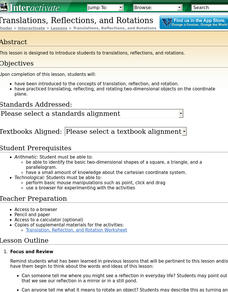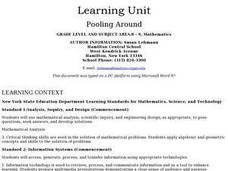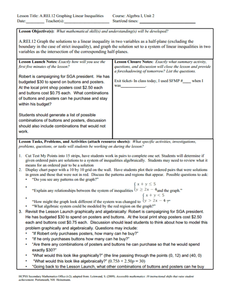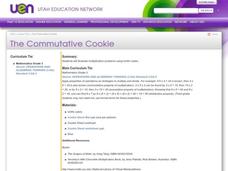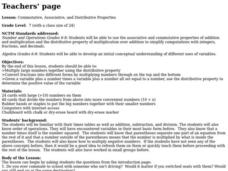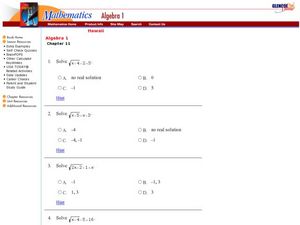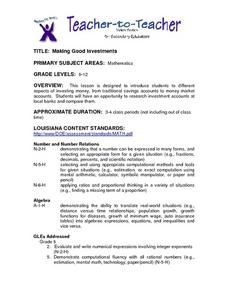Curated OER
Introduction to Arithmetic and Geometric Sequences
Students examine the concept of sequences. Students create a sequence using varied starting numbers, multipliers, and add on values. Students practice determining the starting values to use in order to produce a desired sequence.
Curated OER
Exponent Rules
Students engage in a lesson that is concerned with the rules of exponents. They practice solving problems that use exponents in a variety of contexts. Students are shown how to use the rules in numerical sequences and after translation...
Curated OER
Finding Remainders in Pascal's Triangle
Students use clock arithmetic to find remainders. In this patterns in math lesson, students explore the relationship between clock arithmetic and remainders using a computer applet. Students also identify patterns in Pascal's triangle...
Pennsylvania Department of Education
Adding and Subtracting Rational Numbers to Solve Problems
High schoolers explore the concept of probability. In this probability lesson, students use area to determine probability. High schoolers use charts and spinners to help determine the probability of events such as flipping a...
Curated OER
Translations, Reflections, and Rotations
Tenth graders have been introduced to the concepts of translation, reflection, and rotation, and have practiced translating, reflecting, and rotating two-dimensional objects on the coordinate plane.
Curated OER
Pooling Around
Pupils complete a unit of lessons on computing area and volume. They play a Jeopardy game of basic area formulas, calculate surface area of shapes, develop a Powerpoint presentation, and conduct a simulation of finding the surface area...
Curated OER
Graphing Linear Inequalities
Eighth graders extend skills for representing and solving linear equations to linear inequalities. Lesson activities build understanding and skill by plotting ordered pairs of numbers that either satisfy or do not satisfy a given...
Helping with Math
Solving Equations with Two-Stepping! (2 of 4)
Multi-step problems are part of the progression when learning to solve equations. These 12 problems require only two steps to arrive at an answer. Either print the page out to assign as homework, or have learners write down the problems...
Pennsylvania Department of Education
Extending Pattern Understandings
Students use shapes and manipulatives to demonstrate patterns. In this patterns lesson plan, students also break up patterns to identify a pattern unit.
Curated OER
Cross Section and Slope
Students draw cross sections of given contour maps. In this math lesson, students interpret the different symbols used in the map. They determine slope and steepness through direct measurement.
Curated OER
Substitution Process in Problem Solving
Students apply the substitution process to solve equations with more than one variable. They explore how to use the process and when it should be used.
Curated OER
Giggle, Giggle, Quack Pizza Fractions
Young scholars explore the concept of multiplication by using pizza. They read an article discussing how math is used everyday. They try to determine how many pizzas they would need to feed the class.
Curated OER
Family Vacation
Young scholars use math to plan a trip by houseboat down the Mississippi River. They research and obtain information on the Mississippi River and its surroundings and use multiple graphs to represent their data.
Curated OER
Relating Division and Subtraction
Third graders relate the process of division to subtracting equal groups. Through guided practice and teacher demonstration, they complete division problems using a subtraction method. Students complete problems independently for...
Curated OER
The Commutative Cookie
Third graders investigate the commutative properties of multiplication and focus upon the setting of cubes in the correct patterns to solve problems. They differentiate between numbers that have multiple factors and prime numbers....
Curated OER
Linear Systems: Graphical Interpretation of Vectors and Linear Systems
In this interpretation of vectors and linear systems worksheet, students describe the geometric appearance of two vectors. They add the two vectors and sketch the sum as well as the vectors to determine the commutativity of vector...
Curated OER
Expansion of Single Brackets
For this expanding brackets worksheet, students read through an explanation of expanding brackets in mathematical equations and then complete 10 practice problems. Students then complete 58 problems in which they need to work through...
Curated OER
Negative Exponents and Scientific Notation
In this exponent rules instructional activity, students simplify 56 negative exponents and scientific notation problems. Students use exponent rules to simplify each problem.
Curated OER
Commutative, Associative, and Distributive Properties
Students explore the concept of the associative, commutative, and distributive properties. In the associative, commutative, and distributive properties lesson, students discuss real world examples of each property. Students demonstrate...
Curated OER
Radical Equations
In this radical equations worksheet, high schoolers complete short answer questions about radical equations. Students answer 7 questions and look at many examples.
Curated OER
Grade 3-Math Patterns
In this grade 3 patterns worksheet, 3rd graders answer a set of 13 multiple choice questions, finding missing numbers in and completing patterns. Answers may be submitted and checked on-line.
Curated OER
Writing a Number Sentence
Third graders analyze word problems. In this number sentence lesson, 3rd graders evaluate word problems. Students create number sentences from word problems.
Curated OER
Graphing and the Coordinate Plane
Students gain practice reading coordinates and plotting points by participating in the Coordinates! Game. They demonstrate and test their skills with graph paper and the Maze Game.
Curated OER
Making Good Investments
Students compare different aspects of investing money from traditional savings accounts to money market accounts. They research investment accounts at local banks and compare them.






